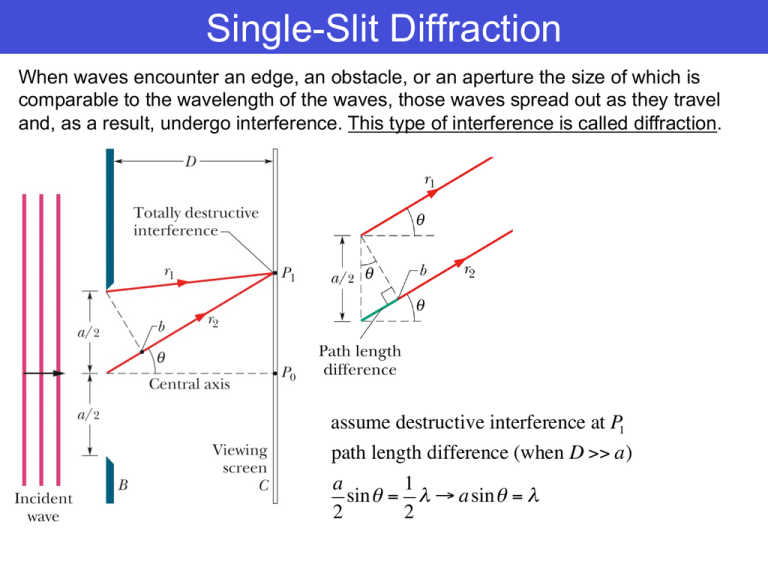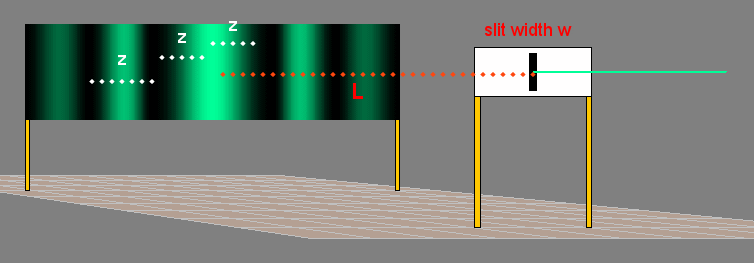
Huygens' principle also holdsįor electromagnetic waves.

With each other to produce the traveling wave. The wavelets emitted by all points on the wave front These wavelets propagate outward with the characteristic Lets us treat wave propagation by considering every point on a wave front to be a secondary source of Diffraction results from the interference of an infinite number of wavesĮmitted by a continuous distribution of source points in two or three dimensions. Passing through a finite aperture to spread out as it propagates. (We already encountered interference when studyingĭiffraction is the tendency of a wave emitted from a finite source or Mathematical treatment is much more involved.ĭiffraction and interference are phenomena observed with all waves.ĭiffraction can only be observed with waves traveling in two or threeĭimensions. Wave optics contains all of ray optics, but the If the wavelengths of the light become comparable to the dimensions of theĮquipment, then we study optical phenomena using the classical theory of radiation, or wave optics. So, as far as visible light is concerned, matter is quasi-continuous. Individual atoms in a solid are separated by distance on the order of 0.1 nm. So a laser beam with a diameter of 1 mm has a diameter of 2000 wavelengths. Wavelengths in the middle of the visible band are on the order of 500 nm. Consider the wavelength scale of light waves. Under these conditions we can make an approximation called In many situations, the wavelengths of the light being studied are very smallĬompared to the dimensions of the equipment used to study the light. Light is a transverse electromagnetic wave. In classical physics, we can classify optical phenomena into one of two categories: ray optics and wave optics. Cloth and feathers, which are both made up of many smaller, thinner parts, produce complicated diffraction patterns.Single slit diffraction Single slit diffraction Light that passes around the hair spreads out, overlaps, and produces a diffraction pattern. Thin objects, such as a strand of hair, also diffract light. In fact, the angle between two adjacent dark bands in the diffraction pattern is inversely proportional to the width of the slit. The narrower the slit, the more the light spreads out. This different amount of bending gives the blobs their colored edges: blue on the inside, red on the outside. Red light, for instance, has a longer wavelength than blue light, so it bends more than blue light does. The angle at which the light bends is proportional to the wavelength of the light. Where the trough of one wave overlaps with the crest of another wave, the waves cancel each other out, and you see a dark band. Where the crest of one wave overlaps with the crest of another wave, the two waves combine to make a bigger wave, and you see a bright blob of light. The light waves that go through the slit spread out, overlap, and add together, producing the diffraction pattern you see. The black bands between the blobs of light show that a wave is associated with the light. Rotate each object while you look through it. Look at the light through a piece of cloth, a feather, a diffraction grating, or a piece of metal screen. Rotate the hair and watch the line of blobs rotate. Move the hair until it is between your eye and the light source, and notice that the light is spread into a line of blobs by the hair, just as it was by the slit. Stretch a hair tight and hold it about 1 inch (2.5 cm) from your eye. Notice that the blobs have blue and red edges and that the blue edges are closer to the light source. As you squeeze the slit together, the blobs of light grow larger and spread apart, moving away from the central light source and becoming easier to see. If you look closely you may see that the line is composed of tiny blobs of light. While looking through the slit, rotate the pencils until they are horizontal, and notice that the line of light becomes vertical. Notice that there is a line of light perpendicular to the slit. Squeeze the pencils together, making the slit smaller.

Hold both pencils close to one eye (about 1 inch away) and look at the light source through the slit between the pencils.

The tape wrapped around one pencil should keep the pencils slightly apart, forming a thin slit between them, just below the tape. Hold up the two pencils, side by side, with the erasers at the top. Place the light on a stable surface at least one arm’s length away from you.


 0 kommentar(er)
0 kommentar(er)
